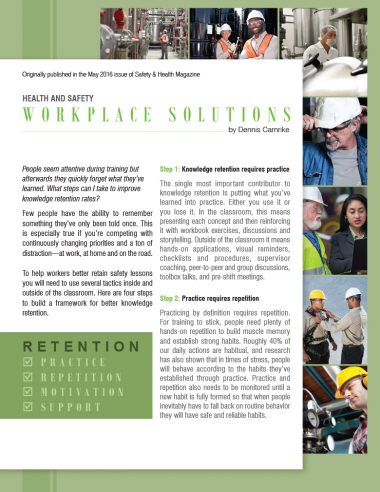This article by Dennis Carnrike was originally published in the
May 2016 issue of Safety & Health Magazine
People seem attentive during training but afterwards they quickly forget what they’ve learned. What steps can I take to improve knowledge retention rates?
Few people have the ability to remember something they’ve only been told once. This is especially true if you’re competing with continuously changing priorities and a ton of distraction—at work, at home and on the road. To help workers better retain safety lessons you will need to use several tactics inside and outside of the classroom. Here are four steps to build a framework for better knowledge retention.

Step 1: Knowledge retention requires practice
The single most important contributor to knowledge retention is putting what you’ve learned into practice. Either you use it or you lose it. In the classroom, this means presenting each concept and then reinforcing it with workbook exercises, discussions and storytelling. Outside of the classroom it means hands-on applications, visual reminders, checklists and procedures, supervisor coaching, peer-to-peer and group discussions, toolbox talks, and pre-shift meetings.
Step 2: Practice requires repetition
Practicing by definition requires repetition. For training to stick, people need plenty of hands-on repetition to build muscle memory and establish strong habits. Roughly 40% of our daily actions are habitual, and research has also shown that in times of stress, people will behave according to the habits they’ve established through practice. Practice and repetition also needs to be monitored until a new habit is fully formed so that when people inevitably have to fall back on routine behavior they will have safe and reliable habits.
Step 3: Repetition requires motivation
Putting this much time and energy into building skills and habits requires both internal and external motivation. You’ll need to plant the seeds for internal motivation within the classroom by talking about the important reasons why the participant is being trained and the personal value they will receive when they’ve mastered their new skills. Hint: focus on their agenda (their safety 24/7, their families, their personal goals, etc.) and not on the corporate agenda (lower injury rates, increased production, etc.).
External motivation will come outside of the classroom with positive feedback from supervisors for doing new tasks correctly, group performance measurement and maybe even contests or rewards. Keep in mind the adage that what gets measured gets done. If remembering safety training is important, find a way to track learning goals.
Step 4: Motivation requires support
Even with the best intentions, it’s easy to deviate from a plan. Think about how many New Year’s resolutions have been broken due to a lack of support. Maintaining motivation throughout the habit-building cycle will require external support from supervisors, peers and sometimes even family members. If a group is building a new skill together, supervisors should encourage them to look out for each other. If only one or two people are building a specific skill, make sure they have a support person designated to discuss their progress and offer positive reinforcement until they’ve solidified success.
As I’ve outlined, learning is a process that begins in the classroom but should continue long after the initial training session has ended. If you use a third party for any aspect of safety training, be sure to evaluate how well they provide ongoing opportunities to sustain learning. And if you’re conducting your own safety training, follow these steps to help people better remember safety training and be able to use it when it matters most.
As SafeStart’s SafeStart Director of Continuity, Dennis brings a relaxed, common-sense approach to integrating human factors safety solutions into business cultures and safety systems. Dennis holds a certificate in Occupational Health and Safety and has spent over 15 years working hands-on with companies of all sizes as they implement SafeStart as part of their efforts to manage human factors within their safety management system.

Get the PDF version
You can download a printable PDF of the article using the button below.

